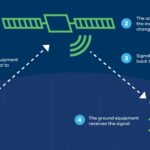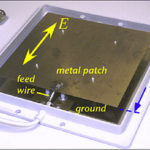Passive RFID tags have been widely adopted, and some applications show creative adaptation to unmet needs.
While many uses for passive RFID tags were predicted and expected, innovators implemented some that were not obvious. This part will look at two of those applications.
Clothing-store “mass” checkout
One obvious application predicted for passive RFID labels was the replacement of the standard bar codes printed on routine items in the supermarket, but that hasn’t happened. The cost of printing the bar code on a label is zero, of course, and using a laser-based scanner works well enough; there is no clear advantage to RFID tags in that situation, except that the tags could be smarter and also have information such as “packed by” or “use by” date codes.
However, a leading fashion retailer had figured out what marketers call a “use case” for basic RFID labels. Uniqlo (their parent company is Japan-based Fast Retailing Co.), with 2400 worldwide stores, started using passive RFID tags to track individual clothing items and the entire received goods, warehousing, and ship-to-store cycle in the early 2000s. Beginning in 2017, Uniqlo had a tag sewn or attached to every individual garment, with RFID readers installed at warehouses, distribution centers, and stores, enabling real-time insight into product location, destination, availability, and even qualities like color and size. The UHF-band tags cost between 2 and 4 cents each.
Different tag styles and sizes are used for different sizes/weights of clothing items, but they are all RFID identical (Figure 1).

It’s one thing to use RFID in the invisible “back side” inventory management and shelf-stocking process, but Uniqlo took it one step further: customer self-checkout. Instead of customers or a clerk scanning a bar code on each item, the customer literally dumps all her purchases into a bin at the checkout desk and closes the lid (Figure 2). Within a few seconds, all the tags are then scanned as one batch, and the total bill is presented on the screen so the customer can review, approve, and pay.

The Uniqlo installation uses tags and a system provided by Impinj, Inc., using the RAIN RFID standard. RAIN RFID is a global alliance promoting the universal adoption of UHF RFID technology in a way similar to other wireless technology organizations including NFC Forum, WiFi Alliance, and Bluetooth SIG. RAIN uses the GS1 UHF Gen2 protocol which ISO/IEC has standardized as 18000-63. The word RAIN — an acronym derived from RAdio frequency IdentificatioN — is intended as a nod to the link between UHF RFID and the cloud.
What do the numbers show about the benefits and acceptance of this dump” self-checkout? Uniqlo says it has been only positive. First, checkout lines have been reduced during busy periods by 30 to 50 percent. Customers apparently like it as well: typically, over half of the customers use this self-checkout, and in some stores, that number typically reaches 80 to 90%.
What about golf?
Golf is obviously a popular sport, and practice hitting bays where players can enhance their long-range driving are important tools for players to keep in shape and improve their long game. Venues such as Top Golf provide this opportunity; and their newest one, opened in late 2023, features a three-story, year-round, 8 am to 11 pm practice facility with 90 hitting bays (three rows of ten bays), each equipped with heaters, fans, and the company’s Toptracer technology (Figure 3). Like the Uniqlo system, it uses RAIN RFID devices from Impinj — but in a very different way.

Using facility-provide clubs or your own set, you hit the balls which then score themselves, using a system based on passive RFID technology. Each ball has an embedded RFID tag which is used to track the ball’s landing (Figure 4).

Instead of physical signs to mark the yardage, there are several hundred RFID readers in the field, forming the various landing zones. The object is not to simply hit the ball as far as possible but to have each land at a desired target zone. Each zone is a circular net with sections, and the closer the hit ball gets to the center of the zone, and the further the zone is in the field (up to 240 yards), the more points you earn. When a ball falls into a zone, the readers scan its RFID chip, and the data is passed back to the Topgolf system to register.
After the raw data has been captured, the many scoring and analytic functions take over to characterize the results in various ways and present them to the golfer. This system keeps track of the scores of approximately 550 people when a complex is at capacity, each with 20 shots to record. The RAIN RFID system can manage over 10,000 ball reads per hour.
The balls themselves are based on standard Calloway balls. In addition to the embedded RFID microchip, which adds a fraction of a gram to the ball, the balls are “flighted” (detuned), so they travel 25 to 50 yards less than ordinary golf balls used on a course. The RFID technology can track the location of each ball, making it easy for staff to locate misplaced balls or see ones that have been “accidentally” packed and so might leave the premises.
The RFID readers in the Impinj Speedway series monitor each of these sub-targets. There are approximately 600 to 700 “read points” throughout the entire complex, keeping track of where the ball hits and automatically giving players the correct score.
While passive RFID was originally looked upon as fairly limited in scope, perhaps offering a way to replace bar codes, do end-to-end asset tracking, and replace card swiping, it has become much more. The two examples show how it has replaced the one-by-one checkout-scanning process and also enabled a new type of golf practice arrangement with detailed visuals and statistics.
Related EE World content
When should passive or active RFID be used?
What is the difference between active and passive RFID?
How do RFID tags and reader antennas work?
RFID Reader Targets Medical, Retail, Transportation Customers
RFID upgrade pushes “ancient” pneumatic-tube system into the 21st century: Part 1
RFID upgrade pushes “ancient” pneumatic-tube system into the 21st century: Part 2
Ultra small RAIN RFID tag for wearables and healthcare
Drones Relay RFID Signals for Inventory Control
Plastic 12-Bit RFID Tag And Read-Out System With Screen-Printed Antenna
Teardown: ArmourCard Active RFID Jammer
Barcodes and Scanners, Part 1: How they work
Barcodes and Scanners, Part 2: History and development
External references
The Wall Street Journal, “The Self-Checkout Even the Haters Will Love”
The Wall Street Journal, “Uniqlo’s Parent Company Bets Big on Tiny RFID Chips”
Impinj, “How Uniqlo Tracks Style and Savings with RAIN RFID”
Focus RFID, “What is the magic that makes UNIQLO choose RFID?”
SEIKO RFID Technology Ltd., “Uniqlo RFID tags”
Feigete Intelligent Technology Co., Ltd. “UNIQLO Applies RFID Tag and RFID Self-Checkout System, These Greatly Streamlines Its Inventory Management Process”
Birdies and Baskets, “How Does Topgolf Track Balls?”
CIO, “Inside look at Topgolf’s high tech driving ranges”
Golf Span, “How Does Topgolf Track Balls? The Technology Explained”
Reddit, “In case any of you wondered what the sensor inside of a Topgolf ball looks like”
Golf news Net, “How do Topgolf golf balls work? Here’s how they know you hit that golf ball”
Impinj, “TopGolf Transforms Golf Driving Ranges with RAIN RFID”
Impinj, “Monza R6 Series RAIN RFID Tag Chips”
Impinj, “RAIN RFID Tag Chips for Item-Level Visibility”
Impinj, “Impinj Speedway RAIN RFID Readers for Flexible Solution Development”
RAIN Alliance, “What is RAIN RFID”
Impinj, “RFID Standards”
GS1 US, “50 Years of GS1”
Xinyeton Technology Development Co, Ltd, “How to Print RFID Tags?”
Xinyeton Technology Development Co, Ltd, “What are the Different Types of RFID Tags?”
Xinyeton Technology Development Co, Ltd, “LF, HF, UHF Frequency: What’s the difference”
Electronics Notes, “RFID Standards: ISO, IEC, EPCglobal”
Wikipedia, “Radio-frequency identification”
RFID4U, “How to Select a Correct RFID Tag – Standards and Mandates”
TechTarget, “RFID (radio frequency identification)”
GAO Group, “How RFID Tags are Designed, Manufactured and Packaged”
InfinID Technology, “Passive RFID Tags”





